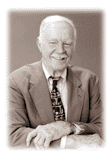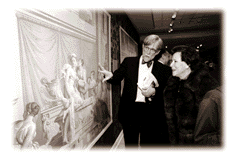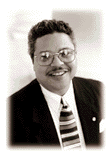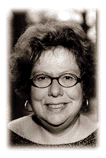Class Notes - April 7, 1999
Class notes features
Brown's passion is population control
 The tap on the claw-foot bathtub drips inexorably, filling the basin
with the liquid "Population." Droplets spill over, feeding puddles
labeled "Hunger," "Poverty," "Congestion,"
and "Pollution." The image encapsulates the problem preoccupying
Newell Brown '39 these days: the multiplying millions crowding onto our
already packed planet, and especially into our increasingly cramped country.
The tap on the claw-foot bathtub drips inexorably, filling the basin
with the liquid "Population." Droplets spill over, feeding puddles
labeled "Hunger," "Poverty," "Congestion,"
and "Pollution." The image encapsulates the problem preoccupying
Newell Brown '39 these days: the multiplying millions crowding onto our
already packed planet, and especially into our increasingly cramped country.
The bathtub logo headed the eight issues of the Tub Tap Times,
a newsletter Brown published out of his New Hampshire home in 1997-98 and
mailed to about 950 graduates of the Princeton and Vassar classes of '59,
folks he figured were nearing the peak of their professional influence.
"It was plausible that if they got interested, they were in a position
to make some waves," Brown says.
From its first issue, the Tub Tap Times hammered hard at Brown's
own controversial prescription for controlling U.S. growth: strict limits
on legal immigration to stabilize the American population and give this
country the standing to lecture others on the dangers of unchecked growth.
While Brown's interest in population issues is longstanding, his activism
is recent. His earlier career included wartime service in Burma with the
CIA's precursor; a decade in government, first in New Hampshire and later
as an assistant secretary in Eisenhower's Department of Labor; and 15 years
as Princeton's director of career counseling. Along the way, Brown and his
then-wife produced five children ("came to wisdom late," the population
crusader has scribbled underneath that line on his résumé.)
After he retired from Princeton in 1979, Brown made his way to the Colorado
mountains, where, between horseback riding and skiing, he self-published
a book on euthanasia, To Call It a Day in Good Season: How Not
to Overstay Your Life.
Back home in New Hampshire, Brown tackled the population problem -- but
the Tub Tap Times, he eventually decided, wasn't the solution. With
the November 1997 issue, Brown included a postcard asking recipients if
he should keep publishing. The meager response gave him his answer.
Brown still proselytizes, pressuring environmental organizations to join
his crusade, testifying before a New Hampshire preservation commission,
writing letters to editors. And he's mulling a new project: a pamphlet,
prospectively titled "How to Die Young as Late as Possible," that
will puncture the pretensions of the aging. "I think if I put this
together with good humor and a little poetry," Brown said, "it
might sell quite well for 10 cents a copy."
-- Deborah Yaffe
19th-century academic art has a home
 Textbooks dismissed 19th-century academic art, the kind of art that
David Farmer *81 deals with, as bad painting. Museums deaccessioned their
holdings in the genre, or moved them to basement storerooms. Art professors
taught their students to disdain the realistic paintings of artists like
Adolphe William Bouguereau, Jean Léon Gérôme, Léon
Lhermitte, and Antoine Louis Barye.
Textbooks dismissed 19th-century academic art, the kind of art that
David Farmer *81 deals with, as bad painting. Museums deaccessioned their
holdings in the genre, or moved them to basement storerooms. Art professors
taught their students to disdain the realistic paintings of artists like
Adolphe William Bouguereau, Jean Léon Gérôme, Léon
Lhermitte, and Antoine Louis Barye.
Farmer (shown, at left, with Kitty Carlisle Hart), who did his dissertation
at Princeton on 16thcentury Flemish art, has always liked the academic painters,
those popular 19th and early 20th-century painters. "A professor of
mine at Princeton, Robert Rosenblum, was one of the first scholars to say
that there was more to 19th-century painting than the Impressionists,"
Farmer says. "He had an ingenious mind, and he promoted the 'other
19th-century art.'"
Since then, Farmer has become founding director of the Dahesh Museum
in New York, which is devoted solely to academic art of the 19th century.
It opened to the public in January 1993. Dr. Salim Dahesh, a writer and
philosopher in Beirut, avidly collected French academic art and moved his
collection to New York when the civil war in Lebanon started. His paintings,
prints, and sculptures form the nucleus of the museum's permanent collection.
Farmer, who has had previous curatorial experience at the Art Institute
of Chicago, the Birmingham Museum of Art, the University Art Museum in Santa
Barbara, and the BuschReisinger Museum at Harvard, has not only worked with
the permanent collection at the Dahesh but has begun an ambitious exhibition
program using work borrowed from around the world. One of the shows featured
winners of the Prix de Rome, a prize that each year went to the École
des Beaux-Arts student who did the best history painting and funded several
years of study at the French Academy in Rome. Another show on Rosa Bonheur,
painter of horses and dogs, drew large crowds.
Recently, Farmer gave an illustrated lecture at the Princeton Club of
New York and then led his audience around the corner to the museum. He talked
with enthusiasm about the current exhibition, "French Oil Sketches
and the Academic Tradition." Art students in France used to draw from
casts for years, then draw from life, and finally got to do oil sketches.
Established painters made oil sketches for finished paintings.
He pointed out how Baron François Pascal Simon Gérard,
in The Tenth of August 1792, which shows the deposition of Louis
XVI and Marie Antoinette in the Legislative Assembly, had outlined the entire
huge composition and begun to model a group in the foreground in monochrome,
and then stopped. The unfinished sketch, Farmer said, gave a brilliant insight
into the methods of the academicians.
Shows planned for next year are "The Victorian Salon," for
which the works will come from the RussellCotes Art Gallery and Museum in
Bournemouth, England, and "Women of the Academy Julian." The Academy
Julian was the only place where women could take courses like the ones taught
at the École des Beaux-Arts, which was for men only. Pictures for
this are coming from Paris, Nice, Warsaw, Cracow, and Belgium.
"Academic art of the 19th century is getting more respect,"
Farmer said. "And we've played a small role in that."
-- Ann Waldron
Fighting the Confederate flag
He said, "No!"
 An impassioned speech by a Princeton alumnus helped defeat a Virginia
proposal in January to display the Confederate flag on special license plates.
An impassioned speech by a Princeton alumnus helped defeat a Virginia
proposal in January to display the Confederate flag on special license plates.
Jerrauld C. Jones '76, a Democratic state legislator from Norfolk, told
fellow members of the House of Delegates that the first time he saw the
Confederate flag, he was six years old and the flag was waving next to a
burning cross at a Ku Klux Klan rally. He was returning on a bus from a
field trip. "The fear in that bus was so great you could smell it,"
Jones said.
When he and his brother enrolled at an elementary school in Norfolk a
year later, "We were not only told, 'Nigger stay out, nigger go home,'
but we were greeted with Confederate flags." And when he showed up
in 1968 to integrate the Virginia Episcopal School, a prep school in Lynchburg,
"Nigger go home" was sprayed on the wall of his dorm room, and
Confederate flags were waved in defiance.
"That's what that flag means to me: 'Nigger stay out,'" he
said. "That's the pain and the anger that you will be reminding me
and other African Americans of if you put that flag on the state's official
license plate. ...I remember [those incidents] every day of my life."
After his speech, the House voted to scrap the Confederate flag from
the design of the special plate, which would still feature the words "Sons
of Confederate Veterans." Supporters of the flag design were still
pressing ahead in the Senate.
Jones, who is the chairman of the legislature's black caucus, received
rapt attention and then congratulations from both Democratic and Republican
members. "It was very gratifying, but the outcome was the most gratifying,"
he says.
Jones recalls that he eventually forged good friendships with white students
at Virginia Episcopal, but soon found himself at a racially polarized Princeton
campus as a freshman in 1972. Unlike the South, he says, there was little
overt racism at Princeton. "But there were subtle and covert experiences
of racism." Still, Princeton was a "breath of fresh air,"
both because it had a black community and because Jones was able to "cross
all of the lines" as a well-known trumpet player on campus. He went
on to attend Washington & Lee University Law School, and joined the
Virginia legislature in 1988.
Jones's speech won accolades from newspaper columnists, and he said he
received mostly positive responses from the public. One Virginia man wrote,
"I am conservative, Republican, white. I wish to thank you for putting
a stop to the notion of having the Confederate flag on Virginia license
plates. I believe that most Americans, black, white, or of other racial
background, see the Confederate flag first and foremost as a symbol of racism."
But some unleashed a barrage of racist insults. One person, addressing
Jones as "Mr. Afro," said blacks were lucky to have been enslaved,
"for today you would beating [sic] grass in Somalia or some other monkey
kingdom in Africa." Another who proclaimed himself not a racist ended
a long diatribe with this challenge: "You people don't want equal rights
-- you want special rights. If you don't like the way things are done in
the United States and do not want to recognize the historic traditions of
Anglo-Saxon Americans, then why the hell don't you go back to Africa and
have your own escape from the big, bad, White man?"
-- Frederic J. Frommer
Frederic J. Frommer is a Washington, D.C.-based writer who freelances
for the Washington Post, CNN, and other news organizations.
Pioneering in graduate school was
easy; finding a bathroom wasn't
 When I turned 50 last year, I celebrated the 25th anniversary of my
enrollment in Princeton's Ph.D. program in art and archaeology. I had majored
in art history at the University of Rochester and entered Syracuse University
for a master's degree, winning a two-year fellowship to study in Florence,
Italy. I transferred to Princeton for my doctorate, not realizing that it
was only in 1969 that Princeton had become coed and that women were relatively
new to the Graduate School as well. I think I was in the second graduate
class to be admitted without regard to sex. In art history at Princeton,
a field extremely popular at Seven Sisters colleges like Bryn Mawr and Smith,
the new policy resulted in an almost instant equalization of the numbers
of men and women in the Ph.D. program.
When I turned 50 last year, I celebrated the 25th anniversary of my
enrollment in Princeton's Ph.D. program in art and archaeology. I had majored
in art history at the University of Rochester and entered Syracuse University
for a master's degree, winning a two-year fellowship to study in Florence,
Italy. I transferred to Princeton for my doctorate, not realizing that it
was only in 1969 that Princeton had become coed and that women were relatively
new to the Graduate School as well. I think I was in the second graduate
class to be admitted without regard to sex. In art history at Princeton,
a field extremely popular at Seven Sisters colleges like Bryn Mawr and Smith,
the new policy resulted in an almost instant equalization of the numbers
of men and women in the Ph.D. program.
I arrived at the Graduate College in the fall of 1972, blissfully unaware
that Princeton hadn't had much time to deal with instant coeducation. One
day there were no women at the GC, and the next minute there we were, needing
bathrooms. Fitting even my meager possessions into a New GC single designed
for a spartan man took some doing. The rooms on each corridor of the New
GC were shared by both sexes, but the bathroom, right next door to my room,
was off-limits to women. I had to walk over to the next entrance to use
the facility designated for female use.
I quickly became close to the women graduate students around me, but
we made relatively few friends among our male neighbors, toward whom we
maintained a kind of embarrassed cordiality as we shuffled past each other
in our flip-flops and wrappers to the inconveniently located sanitary facilities.
There was always a feeling in those early years at the GC, which I think
the pioneering undergraduate women shared, that we lived in a kind of vacuum
because there were no social traditions for us to embrace. It felt like
we were a separate work group embedded in the larger male fabric of Princeton.
This vacuum was not characteristic of my experience with the art and
archaeology department. The faculty offered gentility and support to all
the graduate students in the program. The gentility in particular went a
long way toward integrating women students into the formerly all-male bastions
of the department. As one of the professors with whom I studied remarked,
the women students made the place more interesting. At that time, art and
archaeology had only one tenured woman professor, an expert on Greek sculpture,
who was an ardent supporter of women academics and a spectacularly good
teacher. She retreated back to New York City after a few years at Princeton,
partly because she got tired of being the only senior woman in the department.
There were a couple of female assistant professors but neither made it to
tenure. The scarcity of women role models didn't bother me much, the program
was so exciting and challenging. And there were plenty of other women graduate
students to bond with.
Our favorite haunt was the Kienbusch Memorial Ladies Room in the lobby
of McCormick Hall, the home of art and archaeology. The inspired Mrs. Kienbusch,
wife of William A. Kienbusch '36, who was a noted member of the Ogunquit
school of painters, endowed this luxury suite when she discovered the paucity
of facilities for women while on a campus visit. The Kienbusch restroom,
now defunct, boasted a sumptuous lounge with sofa and easy chairs, marble
tables, and some Kienbusch watercolors. We women graduate students retreated
to this little piece of heaven several times a day to smoke cigarettes and
gossip.
A few weeks ago, I had an apotheosis of sorts when I attended an Association
of Princeton Graduate Alumni board meeting. Before the meeting, brunch was
served in the Old Common Room. There, I was joined by a young woman just
beginning the Ph.D. program in English. When I excused myself to find a
restroom, my companion asked me if I knew where to find one. I threw back
my shoulders and said as pleasantly as possible: "My dear, I lived
here before you were born." Her beautiful and intelligent eyes widened
as she said in amazement that she had been born in 1976. I chuckled and
replied: "That's right, I'm talking about 1972."
-- Deborah Strom Gibbons *79
Deborah Strom Gibbons writes about art history and nature.
GO TO
the Table of Contents of the current issue
GO TO PAW's
home page
paw@princeton.edu
 The tap on the claw-foot bathtub drips inexorably, filling the basin
with the liquid "Population." Droplets spill over, feeding puddles
labeled "Hunger," "Poverty," "Congestion,"
and "Pollution." The image encapsulates the problem preoccupying
Newell Brown '39 these days: the multiplying millions crowding onto our
already packed planet, and especially into our increasingly cramped country.
The tap on the claw-foot bathtub drips inexorably, filling the basin
with the liquid "Population." Droplets spill over, feeding puddles
labeled "Hunger," "Poverty," "Congestion,"
and "Pollution." The image encapsulates the problem preoccupying
Newell Brown '39 these days: the multiplying millions crowding onto our
already packed planet, and especially into our increasingly cramped country. Textbooks dismissed 19th-century academic art, the kind of art that
David Farmer *81 deals with, as bad painting. Museums deaccessioned their
holdings in the genre, or moved them to basement storerooms. Art professors
taught their students to disdain the realistic paintings of artists like
Adolphe William Bouguereau, Jean Léon Gérôme, Léon
Lhermitte, and Antoine Louis Barye.
Textbooks dismissed 19th-century academic art, the kind of art that
David Farmer *81 deals with, as bad painting. Museums deaccessioned their
holdings in the genre, or moved them to basement storerooms. Art professors
taught their students to disdain the realistic paintings of artists like
Adolphe William Bouguereau, Jean Léon Gérôme, Léon
Lhermitte, and Antoine Louis Barye. An impassioned speech by a Princeton alumnus helped defeat a Virginia
proposal in January to display the Confederate flag on special license plates.
An impassioned speech by a Princeton alumnus helped defeat a Virginia
proposal in January to display the Confederate flag on special license plates. When I turned 50 last year, I celebrated the 25th anniversary of my
enrollment in Princeton's Ph.D. program in art and archaeology. I had majored
in art history at the University of Rochester and entered Syracuse University
for a master's degree, winning a two-year fellowship to study in Florence,
Italy. I transferred to Princeton for my doctorate, not realizing that it
was only in 1969 that Princeton had become coed and that women were relatively
new to the Graduate School as well. I think I was in the second graduate
class to be admitted without regard to sex. In art history at Princeton,
a field extremely popular at Seven Sisters colleges like Bryn Mawr and Smith,
the new policy resulted in an almost instant equalization of the numbers
of men and women in the Ph.D. program.
When I turned 50 last year, I celebrated the 25th anniversary of my
enrollment in Princeton's Ph.D. program in art and archaeology. I had majored
in art history at the University of Rochester and entered Syracuse University
for a master's degree, winning a two-year fellowship to study in Florence,
Italy. I transferred to Princeton for my doctorate, not realizing that it
was only in 1969 that Princeton had become coed and that women were relatively
new to the Graduate School as well. I think I was in the second graduate
class to be admitted without regard to sex. In art history at Princeton,
a field extremely popular at Seven Sisters colleges like Bryn Mawr and Smith,
the new policy resulted in an almost instant equalization of the numbers
of men and women in the Ph.D. program.